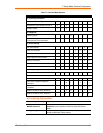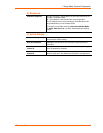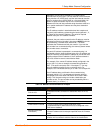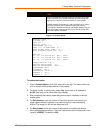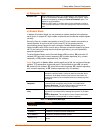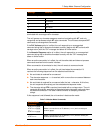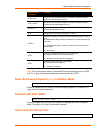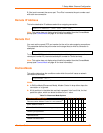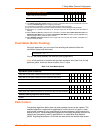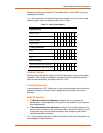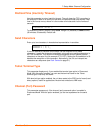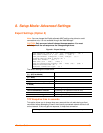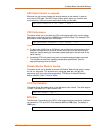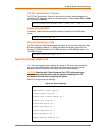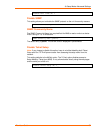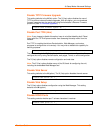
7: Setup Mode: Channel Configuration
Disconnect Mode Option
7
6
5
4
3
2
1
0
State LED off with connection
(4)
1
Disconnect with EOT (^D)
(5)
1
(1) The Telnet Com Port Control feature is used in conjunction with Com Port Redirector. The unit
sends the Terminal Type upon an outgoing connection.
(2) A password is required for a connection to the serial port from the network.
(3) The TCP connection closes even if the remote site does not acknowledge the disconnection.
(4) When there is a network connection to or from the serial port, the state LED turns off instead of
blinking.
(5) When Ctrl+D or Hex 04 is detected, the connection is dropped. Both Telnet Com Port Cntrl and
Disconnect with EOT must be enabled for Disconnect with EOT to function properly. Ctrl+D is only
detected going from the serial port to the network.
(6) When Modem Control In transitions from a high state to a low state, the network connection to or
from the serial port drops.
Flush Mode (Buffer Flushing)
Using this parameter, you can control line handling and network buffers with
connection startup and disconnect.
FlushMode (00) ? _
You can also select between two different packing algorithms.
Note: All bit positions in the table that are blank represent “don’t care” bits, for that
particular option, which can be set to either a 0 or 1 value.
Table 7-10. Flush Mode Options
Function
7
6
5
4
3
2
1
0
Input Buffer (Serial to Network)
Clear with a connection initiated from the device to the network
1
Clear with a connection initiated from the network to the device
1
Clear when the network connection to or from the device is disconnected
1
Output Buffer (Network to Serial)
Clear with a connection initiated from the device to the network
1
Clear with a connection initiated from the network to the device
1
Clear when the network connection to or from the device is disconnected
1
Alternate Packing Algorithm (Pack Control)
Enable
1
Pack Control
The packing algorithms define how and when packets are sent to the network. The
standard algorithm is optimized for applications in which the unit is used in a local
environment, allowing for very small delays for single characters, while keeping the
packet count low. The alternate packing algorithm minimizes the packet count on the
network and is especially useful in applications in a routed Wide Area Network
(WAN). Adjusting parameters in this mode can economize the network data stream.
xPico User Guide 51



